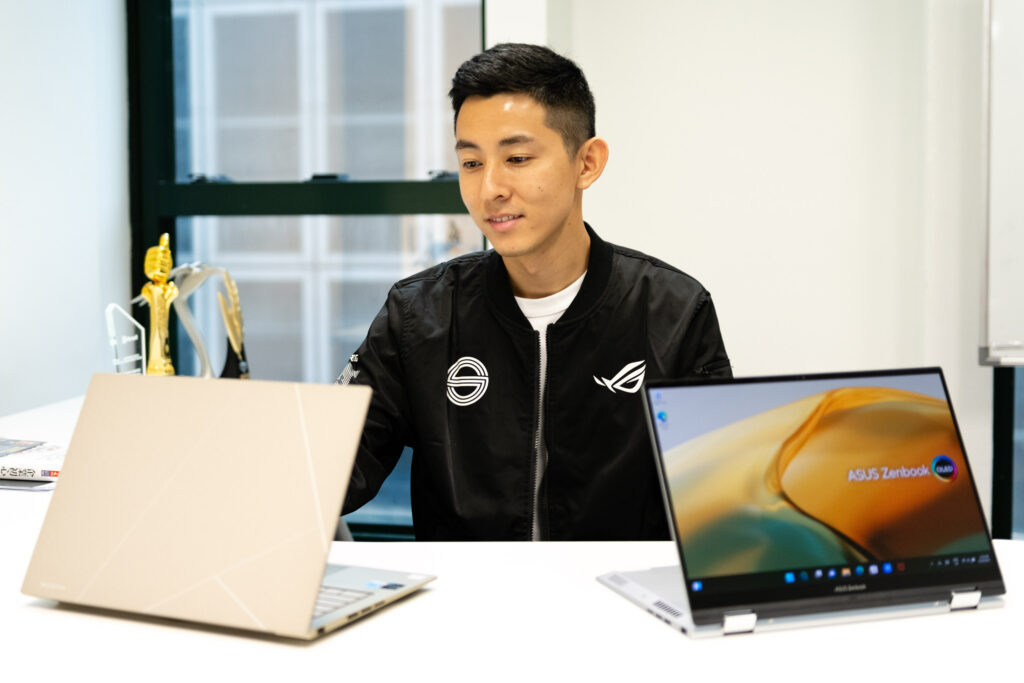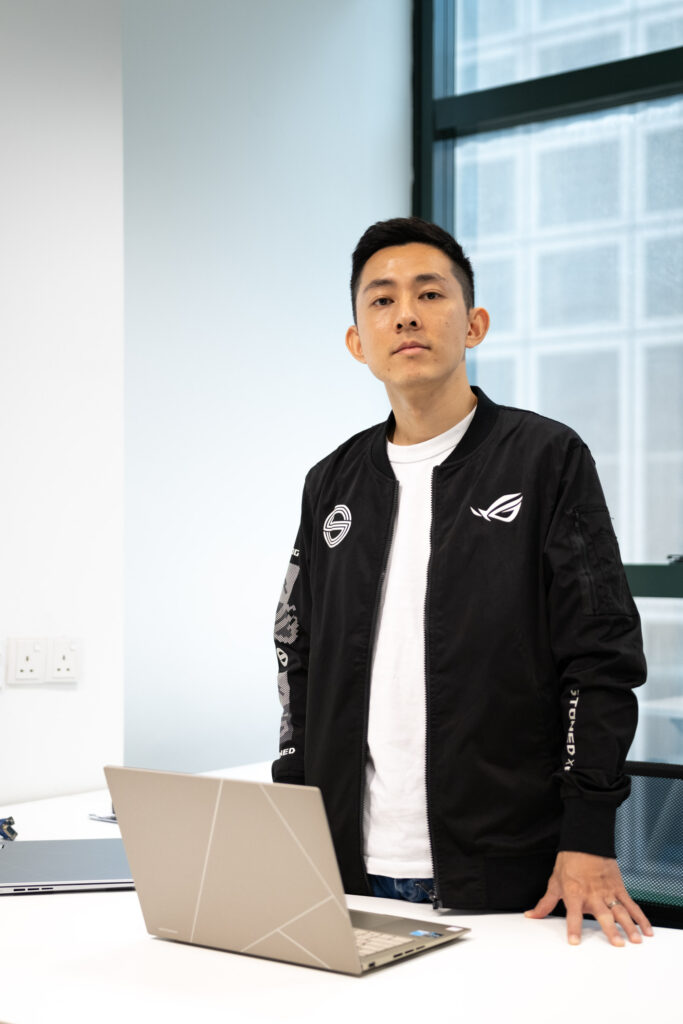
Taking Stock of a Brighter Sustainable Future for ASUS OLED Laptops with Lenny Lin of ASUS Malaysia
Hitech Century speaks to Lenny Lin, Business Development Manager of ASUS Malaysia about their latest 2023 range of laptops which are making waves on account of their brighter, more energy efficient OLED displays along with their latest efforts in inculcating sustainability in their packaging, their product designs and their practices in Malaysia…

Lenny Lin, Business Development Manager of ASUS Malaysia
HC: From a topline view, can you share more about the latest 2023 range of ASUS laptops that were revealed at CES 2023 and which are arriving in Malaysia? Why is there an increased emphasis on thin and light form factors in the line-up?
Table of Contents
Lenny Lin: Most of the laptops announced at CES 2023 will be launched in Malaysia. Among the most exciting products introduced during CES 2023 would be our ASUS Spatial Vision laptops.
I am sure you experienced the ProArt Studiobook 16 3D OLED during the preview in Malaysia earlier this year. It will be introduced during the second half of 2023 to bring an all-new dimension to the OLED visual experience we have been highlighting and focusing on for the past few years.
Next, to address your question on our focus on the thin-and-light segment, it has been our pioneering segment for quite a few years. We worked closely with Intel to introduce our Zenbooks as some of the earliest Ultrabooks ever in the market.
Over the years we have added more powerful offerings to our Zenbook family with the Zenbook Pro series, but we have also stayed close to the roots of the Zenbook series with our Zenbook Classic and Zenbook S lineups. This year’s Zenbook S13 OLED revitalises the Zenbook DNA once again, with an ultra-thin, ultra-light form factor that measures just 1kg and 1cm.
HC: The new 2023 line-up of OLED display equipped laptops cover the range from high-end Zenbooks to mainstream Vivobooks. Why is there an emphasis on OLED displays in the latest generation of laptops and what additional features are there that make the new line-up of laptops such as the new Zenbook S 13 OLED unique?
Lenny Lin: We have focused on introducing ASUS OLED displays across our product range as we believe that the advantages of OLED like lower blue light emissions, accurate colours, and a wider colour gamut benefit everyone.
ASUS works closely with panel vendors to deliver the best user experience with features like pixel shift and other burn-in prevention technologies, addressing the main concern of end users when it comes to OLED display technology.
HC: What exactly are the new Lumina OLED displays that are in the new ASUS OLED laptops for 2023? How do they differ from mainstream OLED technology and why should they be of interest for content creators and other professions who require colour accuracy?
Lenny Lin: We introduced the first ASUS OLED laptop back in 2019, and as you mentioned earlier, we have been bringing ASUS OLED displays to more and more models in our range of offerings. ASUS Lumina OLED is the new name we will be adopting to differentiate us from the competition who have started using OLED display panels as well.
ASUS Lumina OLED represents the close integration between the OLED hardware and our exclusive features like Pantone Validated colour accuracy, TUV Rheinland-certified low blue light and flicker-free dimming, ASUS Splendid customizable colour gamut, OLED power saving and ASUS OLED Care, all of which are intended to deliver the best OLED experience.
I believe ASUS Lumina OLED is perfect for content creators. Like I shared, everyone can benefit from ASUS Lumina OLED displays, but content creators stand to benefit the most. With the Delta E < 1 colour accuracy, wide 100% DCI-P3 gamut, precise colour accuracy at all brightness levels, and customizable colour gamut to suit any content they are working on.
I honestly don’t think any content creator can go back to non-OLED panels after experiencing our ASUS Lumina OLED displays.
HC: OLED displays typically cost more than LCDs. How is ASUS able to integrate OLED displays across their entire line-up including budget laptops like the Vivobook series?
Lenny Lin: The prices of LCD and OLED panels themselves may differ depending on sizes, resolution and other specifications. As OLED displays provide a better user experience in many aspects, we cannot compare the two types of panels only by the price.
As with any technology, OLED technology is maturing, and prices are gradually coming down, which allows us to integrate OLED panels into our more affordable offerings. So do look forward to more ASUS laptops with ASUS Lumina OLED soon!
HC: How does ASUS balance the desire for premium, high-performance laptops with the need to be environmentally conscious and sustainable?
Lenny Lin: I would say that these go hand in hand. There’s no need to compromise one for the other. A good example is our latest Zenbook S 13 OLED. Featuring the latest 13th Gen Intel Core processors, you will not be left wanting in terms of performance. The entire build feels premium, despite being crafted out of post-industrial recycled materials.
As a bonus, the new Plasma Ceramic Aluminum finish which is featured on the Zenbook S 13 OLED is not just beautiful to look at and nice to touch, the plasma electrolytic oxidation (PEO) process to turn aluminum into Plasma Ceramic Aluminum is also a very environmentally friendly one, with the use of 99% pure water that can be disposed into municipal waste channels after neutralisation.
HC: What eco-friendly features does the new ASUS OLED laptop include, and how do they contribute to the company’s sustainability efforts?
Lenny Lin: The aforementioned Zenbook S 13 OLED is carbon neutral, which is a step forward towards our target of achieving 100% renewable energy usage globally by 2035. By 2050, the goal is to eliminate all carbon emissions and work towards achieving net-zero.
Some of our other models also feature packaging made of recycled paper, reusable packaging that can be turned into stands. Meanwhile, our 2023 lineup at least meet EPEAT Silver standards, and are ENERGY STAR certified, ensuring that we are on track towards our sustainability goals.
HC: How important is sustainability to ASUS, and how does the company plan to continue making environmentally conscious choices in the future?
Lenny Lin: Just recently, we were recognised for the second consecutive time as part of the prestigious Climate Leaders Asia-Pacific. At ASUS we have incorporated sustainable development goals into the corporate decision-making process to make positive contributions to society and the environment through practical action.
The ASUS 2025 Sustainability Goals also further strengthen our commitment to the environment and society, focusing on a circular economy, responsible manufacturing, climate action and value creation.
The goals are not just there for us – while we strive towards 100% renewable energy use in our Taiwan-based operations by 2030, and in our offices worldwide by 2035, on top of ensuring that our products are more efficient by ensuring that our products exceed ENERGY STAR standards by 30% every year – but also ensure that our suppliers achieve 30% lower carbon intensity by 2025.
Not just that, we will ensure that all our tantalum, tin, tungsten, gold and cobalt come from responsible, qualified smelters. And of course, we want to encourage a circular economy by achieving a global recycling rate of 20% for ASUS products.
HC: One of the latest ASUS laptops that is now available in Malaysia is the Zenbook S 13 OLED. In terms of its ultralight 1kg and slim design, wouldn’t it overlap and make the prior ExpertBook B9 enterprise series redundant? How is it able to achieve these weight savings?
Lenny Lin: This is a very good question! Let me address the second half of your question first. The ASUS Zenbook S 13 OLED and ExpertBook B9 get their weight savings in very similar ways, as in they feature premium magnesium alloys in their constructions, allowing them to be ultra-lightweight while still meeting our stringent military-grade durability standards.
And now onto the first part of your question. While the weight of these two models might be quite similar, the ExpertBook B9 is packed with enterprise-grade security features like an NFC reader, AdaptiveLock and it can also be configured with a vPro CPU to enable enhanced security and manageability.
While a regular consumer may not find these features to be all that useful, the ExpertBook B9 is catered to enterprise users who require seamless security and management features. And it goes without saying that the price segments of these two laptops are also quite different. So no, I truly believe that these two laptops do not overlap and make each other redundant.
HC: What makes the Zenbook S 13 OLED unique and different compared to its competitors?
Lenny Lin: The main unique selling point of the Zenbook S 13 OLED is obviously it’s 1kg light and 1cm thin design. It is the world’s slimmest OLED ultralight laptop, and we are very proud of this achievement.
Our engineers went the extra mile to ensure that every single component is as thin as it can possibly be. Even the screen bezels were scrutinised, with our engineers using an aluminum bezel for the Zenbook S 13 OLED, versus plastic, which would have resulted in a thicker profile.
All of that thinness does not come at the cost of durability either. As you may know, the Zenbook S 13 OLED meets our stringent US military-grade durability standards, and we are proud to say that our laptops are the most strictly tested laptops, having passed 26 military-grade durability test procedures, the most extensive test regime in the industry for the MIL-STD 810H standard.
And of course, the stunning ASUS Lumina OLED, which delivers brilliant visuals while protecting your eyes at the same time. Finally, the comprehensive port array is also very rare for designs this thin.
Our engineers managed to cram in a full-sized HDMI port, full-sized USB-A port and still had room for two Thunderbolt 4 ports and a headphone jack, to ensure that users don’t have to deal with cumbersome dongles or adapters.
I can’t really nail it down to one feature that really sets our Zenbook S 13 OLED apart from the competition, but I would say it is more of a combination of everything that we put into the Zenbook S 13 OLED that makes it unique among the competition.
HC: How has ASUS incorporated user feedback into the design and development of the Zenbook S 13 OLED?
Lenny Lin: We always take into account user feedback when developing our upcoming products, and the Zenbook S 13 OLED has two rather shining examples of it.
The 2022 Zenbook S 13 OLED featured a trio of USB-C ports to keep the profile slim, but reviewers and users commented that having to rely on dongles or hubs for simple peripherals and display output was not really ideal. Therefore, we implemented a full array of I/O ports to address this feedback.
The concerns about noise levels under heavy loads with the single-fan cooling solution in last year’s model were addressed too, with a new dual-fan cooling system in the 2023 Zenbook S 13 OLED that can run more silently while also being thinner to allow for the ultrathin profile of this year’s design.

HC: For enterprise users, what kind of biometric, encryption and security measures are in place on the Zenbook S 13 OLED?
Lenny Lin: I would say that the Zenbook S 13 OLED has sufficient security features for just about everyone, with TPM 2.0, IR facial recognition with Windows Hello support, device encryption to keep your data secure, and McAfee LiveSafe being pre-installed to keep users safe from online threats.
However, enterprise users usually require even greater security and manageability features, such as NFC login, or Intel vPro, which aren’t available on the Zenbook S 13 OLED. For those, you would need to look towards our ExpertBook series, which I felt personally are better suited for enterprise deployments.
HC: How does the Zenbook S 13 OLED fit into the larger ASUS Laptop Series lineup, and what kind of future developments can end-user & customers expect from this product line?
Lenny Lin: We are always looking towards meeting the needs of everyone with our ASUS laptops, and as we all know, there’s no one-size-fits-all when it comes to laptops. The Zenbook S series is a lineup that focuses on bringing premium aesthetics and features in an ultraportable form factor.
Customers can expect the Zenbook S series to push the limits of thin and light machines, without sacrificing practicality, as you have seen with the Zenbook S 13 OLED. I can’t comment on future developments for now, but at ASUS we are always in search of incredible, so stay tuned for even more impressive ultra portables coming your way.
HC: In regards to the new ROG Ally, why was it revealed as an April Fool’s Joke? Are there any plans in the pipeline for any collaborations with game developers for exclusives, DLCs and for the current or perhaps ROG Ally 2 later on down the line?
Lenny Lin: Our objective was to use April Fool’s day to build a sense of curiosity among our audience about the possibility of such an amazing product to eventually amplify the excitement when people realized we were serious and planning this revolutionary product.
Back to the pipeline plan, It’s difficult to reveal our future collaborations or upcoming products, but you might have noticed we have preloaded Moving Out in the ROG Ally.
If we look further into the ROG ecosystem, we have also collaborated with Techland to optimise Dying Light 2 to take advantage of the ROG Zephyrus Duo’s secondary screen. So yes, we are always in talks with game developers and our partners to further enhance the overall experience that we can bring to our users.
HC: The cardboard laptop stands made of cardboard look like a great idea in concept but the nature of their recyclable design makes them fall apart after a few months of use or after encountering one spilled cup of coffee. Can ASUS ship a more durable laptop stand instead like the one used in the UX482?
Lenny Lin: That’s why we included two with our Zenbook S 13 OLED! Jokes aside, it’s really a balance of what we want to achieve with each design.
The Zenbook 14 Duo UX482 came with the ErgoLift Stand to elevate the secondary ScreenPad Plus display to a more ergonomic position for writing or drawing. For the Zenbook S 13 OLED, the ErgoLift hinge provides for a comfortable typing experience, and the stands are just extras that you can leave on your desk at home to raise it up.

To check out the Asus Zenbook S13 OLED UX5304, check out their official page here.
